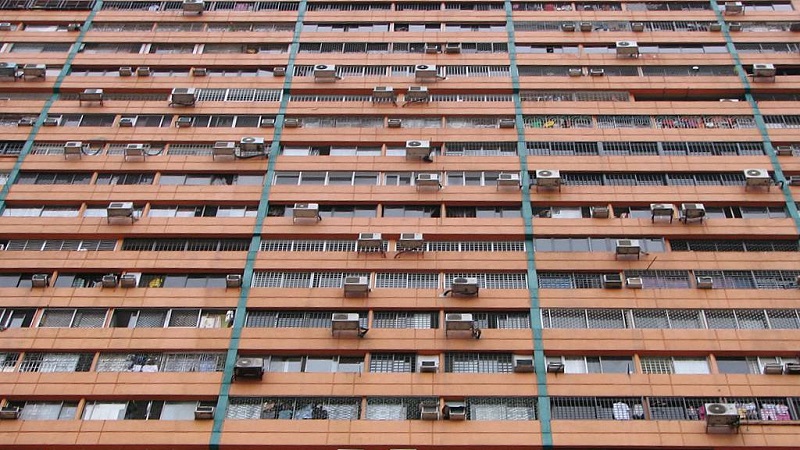HFCs. Ever heard of them? They are chilling your vegetables, cooling your office and keeping your hairdo in place.
Unfortunately hydrofluorocarbons, to give them their full name, are a timebomb for the climate. As demand for air conditioning surges, these manufactured gases could raise global temperatures by up to 0.5C this century.
Next week, national delegates meet in Kigali, the Rwandan capital, to try and agree a phase-out.
More than 100 countries including the US, EU and islands threatened by rising sea levels are pushing for an ambitious deal. Others like India and Gulf states fear the economic impacts of a swift transition.
Here’s all you need to know about the coming battle.
What’s at stake?
A unit of HFC traps up to 23,000 times the heat of a unit of CO2, making these refrigerants much more dangerous than CO2 in the long run.
Scientists calculate that replacing them with greener alternatives could prevent global warming of 0.35-0.5C by 2100. It may not sound like much, but 0.5C was the heart of the debate towards a climate deal in Paris. Low-lying island states say the difference between 1.5C and 2C is a life or death matter.
The Montreal Protocol
HFCs were introduced relatively recently, to replace the the ozone-destroying chlorofluorocarbons (CFCs) banned under the Montreal Protocol in 1987. At the time, they provided a much needed alternative which allowed the ozone layer to repair itself.
Now, the plan is to repeat the trick for HFCs, using the same treaty. The small number of companies producing ozone-depleting gases helped to keep the process manageable in 1987. Observers believe that the same industry-driven process could happen this year in Kigali.
“Today we are in a better position than when the deal was first sealed,” says Clare Perry, climate campaign leader at the Environmental Investigation Agency (EIA). “At the time there weren’t any known alternatives to CFCs. Today we have plenty on our plate, including a range of future-proof choices such as propane or CO2.”
Are we all on the same page?
After the Paris Agreement, there is momentum for a deal. But political differences remain.
Prior to the meeting, a group of more than 100 countries proposed an early freeze date, which is meant to reduce the damage caused by the coolants by capping them in 2021 at the latest. The group includes the United States, the European Union, the 54 countries of the African continent, Argentina, Chile, Colombia and a few island states.
India is set on a much slower phase-out, with a 2031 freeze date. This means that the country can ramp up its HFC emissions for another 15 years.
Earlier this month India’s environment minister, Anil Madhav Dave, told the Times of India:”We will make sure that development of India is not compromised. We must get enough time before the phasing out period starts. We are very clear.”
Why the reluctance?
Well, it’s partly down to cost. India’s scenario will cost €12 billion (US$13.4 billion), compared to 34 billion (US$38.1 billion) for the developed countries’ proposal, the Delhi based think-tank Council on Energy, Environment and Water estimates.
More importantly, it is about market share. India is worried its chemicals industry will lose out to US companies like Honeywell and Chemours (previously DuPont) with bigger R&D budgets.
“A global switch to a different type of coolant is great for chemical companies,” says EIA’s Perry. “Because they make a lot of money out of new patents. But over time, it’s developing countries that will pay a high price for intellectual property rights.”
How to bridge the gap?
As always, finance and technical support will be key.
R R Rashmi, special secretary in India’s environment ministry, told the Economic Times: “There are different estimates as to what it will cost to make the switch. But, we must emphasise in Kigali that the commitment of donor countries has to be absolute and this assurance is necessary to fulfil any commitments India makes.”
A group of philanthropists and donor countries has pledged US$80 million to help poorer countries replace HFCs and improve energy efficiency.
“The US are championing HFCs phase-out at a global level, and it’s very important that they help make possible for developing nations to follow suit,” says Avipsa Mahapatra, global climate campaign lead at EIA.
“They will play an important part in the financial aspect of the talks, for example involving more donors to ensure as much support as possible to poorer nations.”
The last word
“My hope is that [the summit] is well attended and that we agree an ambitious amendment to the Montreal Protocol to phase out HFCs,” Vincent Biruta, Rwanda’s minister for natural resources, told Climate Home last month.
“Countries have various concerns depending on their status as consumers or manufacturers. We need to take all of these into consideration and make sure there is enough to bring everybody on board.”
